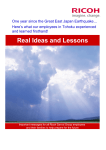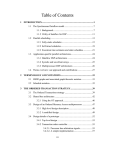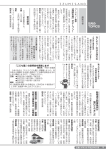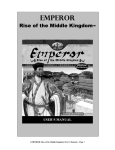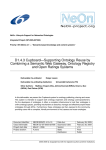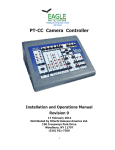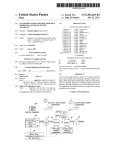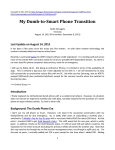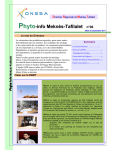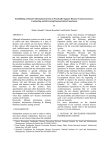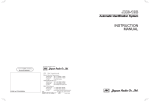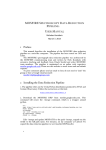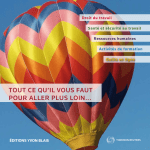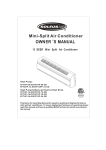Download City Life June-July, 2014(PDF:1485KB)
Transcript
JUNE / JULY 2014 SUMMER EDITION E F I L CITY The Summer Sun – and rain The start of summer in Japan is marked by the plum rains, tsuyu, which drench the country for as much as a month and a half. As with other natural seasonal phenomena in Japan, tsuyu makes its way from one end of the country to the other. Like sakura, the plum rains make their way from south to north. Tsuyu is associated with an inescapable mildew-causing damp and the nourishment of Japan’s many rice fields. Tsuyu is written with the Chinese characters (kanji) for plum (梅) and rain (雨) and can also be pronounced “baiu”. When tsuyu ends, summer proper is deemed to have begun, and the temperature quickly rises. Summer in most of Japan is hot and humid with the temperature in major cities often remaining above 30 degrees centigrade for days on end. This is in large part caused by the “heat island effect” which is found in cities all over the world and refers to urban areas having higher temperatures than the surrounding countryside because of, amongst other things, the retention of heat by manmade surfaces such as concrete and asphalt. This can make Sakai pretty warm too – some places to go to escape the heat include Sakai’s three outdoor pools (Izumigaoka, Ohama Park, and Kanaoka Park – prices inside), public libraries, the Sakai City Museum, Sofia Sakai planetarium (which are all air conditioned) and so on. The most important thing is to drink plenty of water (and eat plenty of ice cream!). Heat stroke or “necchusho” is a major danger in summer and can be avoided by the intake of plenty of liquids and sticking to the shade during the middle of the day. The long months of summer this year will also be a great chance to visit Sakai City Museum’s brand new attraction – an audiovisual masterpiece that will bring you closer than ever before to Sakai’s landmark tumuli. Ever wondered what the inner moats of Nintoku-tenno-ryo Kofun look like? Ever wondered what the kofun used to look like before they were covered with trees? Well, now’s your chance to find out! The Mozu Kofungun Theatre was opened at the same time as a refurbished exhibit on the tumuli in the Sakai area which is [Cont. overleaf] Inside this issue: Night Fish Market 2 Knife-making 2 Torrential Rain 3 Culture Seminar 3 Sakai City Museum 4 Health & Safety 5 Calendars 6 Message from the Editor Hello everyone! It looks set to be another really hot summer—many places have already hit 30 degrees (and I’m writing this in May!) In this issue of City Life you will find a bit of information on events going on throughout the summer and a lot of details on more serious things. At any rate, enjoy the summer months and don’t forget to drink plenty of water! All the best, Felix 1-L5-14-0045 PAGE TWO CITY LIFE Please bear in mind... SAKAI NO TAKUMI - An Exhibition by a Team of Sakai’s Elite Bladesmiths Most of the contact details below will only offer assistance in Japanese. At the Sakai City International Department, we can help find the answer to simple questions and where necessary, put you in touch with a volunteer interpreter service. From 10:00 am to 2:00 pm on the 8th of June (Sun) a number of Sakai’s traditional bladesmiths, including Mr Tadashi Enami and four others, will be holding knife making demonstrations in Daisen Park’s Japanese garden. Watchers will be given the chance to swing the hammer a bit themselves. The schedule for traditional smithing demonstrations is as follows: 10:00 am – 10:30 am 11:00 am – 11:30 am 1:00 pm – 1:30 pm Please contact Felix at the International Department (TEL) 072-222-7343 or (Email) kokusai@ city.sakai.lg.jp The event may be cancelled in the event of bad weather. The exhibition is free to watch and no bookings are required, however the Japanese garden’s entry fee applies: General: 200 yen Children: 100 yen Those 65 and over and the disabled go free Please direct enquiries to the Daisen Park Office (TEL-FAX) 072-247-3670 These pictures are from the exhibition held during the Sakai Festival. Smoking and Littering Please be aware that there’s a citywide ban on smoking and littering on streets and roads in Sakai, and that there’s an awareness raising campaign being held in the areas around major stations in city. In particular, the areas in front of Sakai Higashi Station and Sakai Station, around the Sakai City Office, and along Oshoji St. have been designated as a smoke-free zone—if you’re caught smoking or littering, you could face a ¥1,000 fine—even if you’re riding a bike or scooter at the time! Let’s all work together as a city to make Sakai a safe and comfortable community, free from litter and second-hand smoke! Please call the Public Sanitation Division on 072228-7429 if you have any questions. Sakai Station sh O tre iS oj et Sakai Higashi Station Sakai Grand Evening Fish Market This year’s Sakai Grand Evening Fish Market will be being held on Thursday, July 31st from 1:00 pm to 9:30 pm. The Sakai Grand Evening Fish Market began as a market for Sakai’s fishermen to sell off fish left over from the offerings they made at Sumiyoshi Grand Shrine to ensure bountiful catches and safe navigation. The market dates back 700 years to the Kamakura period and has become a time-honoured Sakai tradition. Stage events begin, and stall and booth trading starts from 1:00 pm. After 7:00 pm anyone can enjoy haggling with wily fish sellers and participating in the auction for the freshest seafood around. Event Information: 4 – 5 Ohamakita-machi, Sakai Ward. 800 metres west of Sakai Station (Nankai Mainline) Parking: unavailable (incl. Ohama Park) Entry: free Please direct enquiries to the Sakai Grand Evening Fish Market Executive Committee (2-2-3 Nakanocho Nishi, Sakai Ward). (TEL) 072-227-8841 Front Page Continued complete with English, Chinese, and Pools are an excellent place to cool Korean translations. The refuroff during the summer. Sakai has bished Nankai/JR Mikunigaoka Stathree city-owned pools, conveniently tion is also worth having a look at, placed for your bathing pleasure. even if you don’t usually stop there. There a number of new Pool Summer Dates Opening Hours shops, a noodle bar, and a café, Izumigaoka July 1—Sept 7 9:30 am—6:00 pm as well a rooftop garden from which you can get a feeling of Kanaoka Park July 1—Sept 1 9:30 am—5:45 pm the size of Nintoku-tenno-ryo Ohama Park July 1– Sept 1 9:30 am—5:45 pm Kofun. Prices A: 500 JHS: 400 ES: 200 PreS: Free 65+:250 A: 300 JHS/ES: 100 A: 300 JHS/ES: 100 *Kanaoka Pool and Ohama Park Pool offer points cards that allow 6 entries for the price of 5. Coin lockers are 50 yen per usage at all three pools. JUNE / JULY 2014 SUMMER EDITION The 184th View21 Concert Desiderium The June View21 Concert is being held on June 13th (Fri) from 12:10. The concert is titled Desiderium It will take place in the 21st Floor Observation Lobby of the Sakai City Hall. Entry is free. Performer: Kuwata Maki The pieces, all by Chopin, will include Étude Op. 10, No. 3 Étude Op. 10, No. 12 Fantaisie in F minor Op. 49 Nocturne No. 20 Ms Kuwata graduated from Osaka Prefectural Yuhigaoka High School Music Department. She majored in piano in the Osaka College of Music’s Department of Instrumental Music where she won a prize for best performance and graduated top of her class in 2007. Ms Kuwata has performed at many up-and-coming musician concerts and other notable venues. She is registered in the Sakai City Up-and-Coming Artist Bank. Hydrangeas at the Sambo Sewage Treatment Plant During the second week of June, the Sambo Sewage Treatment Plant will be opened to the public so that all can see the 1,000 or so hydrangeas the plant houses. The garden includes 50 different types of hydrangeas. This includes the chance to see rare green hydrangeas and mountain hydrangeas or “tea of heaven”. There is also a potted plant corner where you can enjoy the hydrangea’s charm to your heart’s delight. This year the plant is open from June 7th (Sat) to June 15th (Sun). Hours are 10:00 am – 4:00 pm during the week and 10:00 am – 5:00 pm at the weekend. The Sambo plant is accessible by Nankai Bus. Get off at Matsuya-yamatogawa dori bus stop (Sakai Ward). PAGE THREE Japanese Irises in Shirasagi Park ASEAN Culture Seminar Early June is the time to see Japanese irises and one of the best places in Sakai to enjoy their vivid colours is Shirasagi Park. The Japanese iris was chosen by a popular vote in 1989 as Sakai City’s flower to mark the 100th anniversary of the Sakai formally becoming a city. Following its designation as the city’s flower, it was planted around ponds etc. in the park. In collaboration with the Citizens’ Science Seminar Association, Sakai City will be holding a seminar on Indonesian Batik dyeing where participants will have a chance to design their own original tenugui hand towel. The seminar will take place from 1:00 pm to 4:30 pm on July 8th (Tues) at Sofia Sakai (1426 Fukaishimizu-cho, Naka Ward). The seminar will be taught by textile designer Ms Mutsumi Oku. Every year visitors to the park are presented with a riot of purple, white, and pink. The Japanese iris or “hanashobu” is a horticultural variety of iris derived from irises growing wild in Japan. There are thought to be some 3,000 different varieties of cultivated Japanese iris and they are broadly grouped into three categories: Edotype, Higo-type, and Ise-type. Shirasagi Park’s collection contains some 10,000 irises of around 150 different varieties. The park can be accessed from Shirasagi Station on the Nankai Koya Line. The park entrance is around 200 m south of the station. Entry is free. The participation cost is 1,500 yen per person. Apply by sending your name, address, postcode, telephone number and the name of the seminar (Indonesian Batik) to the ASEAN Week Executive Committee Secretariat by return-paid postcard, fax or email. Applications must arrive by June 20th at the latest. (TEL) 072-222-7343 (FAX) 072-228-7900 (Email) [email protected] (Address) ASEAN Exchange Promotion Office 3-1 Minamikawara-machi Sakai Ward 590-0078 Numbers are limited to 8 applications that will be chosen by ballot. 豪雨 (GO-U) Torrential Rain Last year, Typhoon No. 18 (Man-yi) caused terrible damage in Kyoto Prefecture and other areas. In Sakai as well, the Yamatogawa River rose significantly leading to the evacuation of certain areas. As we head towards this year’s rainy season, it is crucial that all Sakai residents understand what they must do in the event of dangerously heavy rain in their areas. Protecting yourself and your family from harm caused by flooding or landslides can be as simple as making a habit of checking the weather forecast and being alert for weather warnings on the television, radio, and internet. It is also a good idea to know where your nearest evacuation site is, how to get there, and what you have to take if you need to evacuate. Please direct general enquiries to the Crisis Management Office (TEL) 072-228-7605 (FAX) 072-222-7339. More information can be found on the following homepages: http://www.kikikanri1.city.sakai.lg.jp/ index.htm http://www.osaka-kasen-portal.net/ suibou/index.html http://www.osaka-bousai.net/sabou/ Index.html http://www.kkr.mlit.go.jp/yamato/ index.php PAGE FOUR CITY LIFE W h a t ’s o n a t S a k a i C i t y M u s e u m ? Museum Exhibitions The Sakai City Museum is located in Daisen Park. It holds thematic exhibitions in addition to the general exhibition on the history and culture of Sakai. Exhibition: Nukina Suou’s Masterpieces From June 21st (Sat) to September 15th (Mon / public holiday) Venue: First floor exhibition corner Nukina Suou (Kaioku) (1778 – 1863) was a calligrapher born in Awa – Tokushima. While lecturing on Confucianism in Kyoto he produced masterpieces in the styles of Wang Xizhi and his son from Jin Dynasty China and Chu Suiliang from Tang Dynasty China which were found in the works of Heian period calligraphers such as Kukai, and was also a renowned Nan-ga painter. This year marks the 150th anniversary of the Nukina Suou’s death which has led to a boom in interest in Nukina and his works. In response to requests from the calligraphy community for the opening to the public of the celebrated Yamashita Collection which belongs to Sakai City Museum and is one of the three big Nukina collections, this exhibition will be featuring many Nukina pieces so that viewers can get their fill of the beauty of the ink painting world. Nukina’s works form a prime example of calligraphic technique for those interested in shodo and a fine chance to appreciate beautiful Japanese script for everyone. Exhibition: The Treasured Hachigamine Buddhas of the Izuminokuni Hodoji Temple From May 17th (Sat) to June 15th (Sun) Venue: First floor Exhibition Corner Hachigamine Hodoji in southeastern Sakai is an ancient temple renowned for its many cultural treasures. Amongst them, The Sixteen Arhats paintings, designated NaOpen tional Important Cultural Properties, will be on display having recently undergone a six year Closed renovation period that finished in March last year. As this exhibition is to celebrate the anniversary of the completion of their renovation, all 16 will be on show in the same place – an exceedingly rare occurrence. At the same time, various other cultural artifacts kept at Hodoji such as Buddha statues, Buddhist paintings, old scrolls with the temple’s origins written on them, temple name boards and ancient tiles will be on display, shedding light on the history of the former Izuminokuni feudal domain’s ancient temple. Tuesday-Sunday 9:30-17:15 (enter by 16:30) Mondays Year-end and New Year Holidays The day following public holidays Contact museum for details (TEL) 072-245-6201 Admission Museum Entry only Adults University/senior high 200 yen Elementary/junior 100 yen 50 yen Discounts apply for groups (20 persons or more). Junior high school students and elementary pupils attending schools or living in Sakai, as well as foreign exchange students with suitable identification are admitted for free. Spot Display: Reading Old Writing 3rd Opening Hours 6th From June (Tues) to July (Sun) Venue: the Spot Display Corner of the First Floor Permanent Display Hall. Sakai City Museum possesses a lot of historical material, much of which is related to the history of Sakai. Historical documents make up an indispensable part of that material. However, with the exception of those who have been taught how to decipher them and those who have studied Japanese history in depth, people often find such documents fairly inaccessible and unexciting because of the difficulty of the script. This exhibition aims to change that by presenting basic knowledge based on letters and petitions written between the Sengoku Period and the Edo period, while providing explanation of the shape and character of historical documents. Tandem Salon Membership Drive The Tandem Salon is open every Friday, 9:00 am - 5:00 pm, and members can drop in at any time. The Salon will be run in the Kanaoka Public Hall (Kanaoka Kominkan) except on the second Friday of each month when it will be run in the Shinkanaoka Community Centre (Shinkanaoka Shimin Centre). Salon membership costs 2,000 yen. Salon’s official language is English. The Salon is a place where people who want a break from speaking Japanese can go to speak in English – or where people seeking to improve their Japanese can go practice and study. Speakers of all other languages are welcome too! For more details see the blog below or ring or email Maki. Blog: http://multilingualclub.blogspot.jp/ Email: [email protected] PAGE FIVE JUNE / JULY 2014 SUMMER EDITION Food Safety A Word from the Fire Bureau Fire Prevention Starts in the Home Most of the fires that occurred within the Sakai Fire Bureau’s area of responsibility last year were building fires, and roughly half of those were residential property fires. Everyone living in Sakai must do their part to stop fires from breaking out. The following tips can help prevent (or help deal with) fires in the home. Fire alarms Most deaths caused by fires in the home occur when people don’t realise there’s a fire until it’s too late. The installation of fire alarms in bedrooms has been made compulsory because of the frequency of deaths caused by fires that break out when people are asleep. If you haven’t had them installed in your house or bedrooms, please do so immediately. Fire alarms in houses generally need to be replaced every five to ten years. Please replace your fire alarm either when the irregularity warning sounds (if your fire alarms have an automatic checking function) or when the alarm reaches the replacement date displayed on it. Please check your fire alarm’s user manual for further details. Fire extinguishers Should a fire break out, often the most effective way to deal with it is to use your home fire extinguisher to put it out. Fire extinguishers are not compulsory but having one is recommended. Flame retardant products Flame retardant products have improved fabric specially designed not to catch fire or to slow the spread of the fire even if they do catch. Examples of such products include flame retardant curtains, bedding, and car body-covers. Again, while these products are not obligatory, their use can go a long way to preventing the outbreak and spread of fires. Basic Japanese Lessons From September to November this year, Sakai International Plaza will be running beginner level Japanese lessons for adults. The lessons will take place during the day time on weekdays. The lessons will be free and are open to adults working, living, or studying in Sakai. Applications will be accepted from July. For more information please contact Sakai International Plaza (TEL) 072-2287499 (Email) [email protected] or check for the update on the City Life homepage at the start of July. Enquiries in English, Chinese, Korean , Spanish and Portuguese welcome. に ほ ん ご June is Sexually Transmitted Disease Prevention Month Public health centres within Sakai City hold anonymous, no booking required testing once a month for HIV antibodies, syphilis and chlamydia. The following testing options are free: HIV test only; and the HIV, syphilis and chlamydia test set. Please note that the chlamydia test requires a urine sample which can only be taken at least one hour after the last urination. In the event that there is a lot of blood in the sample, it is possible that the test may not give correct results. For dates and times, and places, please enquire (in Japanese) to the Infectious Disease Control Division of the Public Health Department ((TEL) 072-2229933 (FAX) 072-222-9876) or one of the public health centres below: Public Health Centres (Japanese language assistance only) Sakai Ward TEL 072-238-0123 Minami Ward FAX 072-227-1593 Naka Ward TEL 072-270-8100 Kita Ward FAX 072-270-8104 Higashi TEL 072-287-8120 Mihara Ward Ward FAX 072-287-8130 Nishi Ward TEL 072-271-2012 Chinugaoka FAX 072-273-3646 TEL 072-293-1222 FAX 072-296-2822 TEL 072-258-6600 FAX 072-258-6614 TEL 072-362-8681 FAX 072-362-8676 TEL 072-241-6484 FAX 072-247-3201 Every year between June and October cases of food poisoning abound. In particular, germs are very active during the hot and humid rainy season. Even though food poisoning bacteria may be present in your food and multiplying, there may be no change in the food’s appearance, smell, or taste, making it very difficult to detect. Pay attention to the following pointers to keep yourself and your family safe. When buying food: Before buying, check the use-by date and level of freshness. Only buy what you need. When buying food that needs to be kept refrigerated or frozen, aim to purchase it last. After buying such food, get it into the fridge or freezer as soon as you can. Storage: Generally, fridges should be kept below 10 °C and freezers below -15 °C. Leaving your fridge or freezer’s door open, or putting too much inside it can cause the inside temperature to increase, so aim to close the door as soon as you can when taking things out, and try not to fill your fridge or freezer above 70 percent. When cooking: Always wash your hands before preparing food. Make sure you also wash your chopping board and knives in hot water before you start cooking. In particular, after handling raw meat or fish, be sure to wash your hands and cooking utensils before handling other food. When heating food, ensure that it is cooked through (i.e. that the centre of the piece of meat etc. is thoroughly cooked). Eating: After food has been prepared, try to eat it straight away. If it is likely to be a while before you eat the food, do not leave it at room temperature – put it in a shallow dish where it will cool easily, and then place the dish in the freezer or fridge. When you eat it after that, be sure to reheat it thoroughly. When you have a barbeque, keep chopsticks used for handling the raw meat separate from the ones used for eating. Enquiries: Food Sanitation Division (TEL) 072-222-9925 (FAX) 072-222-1406 PAGE SIX CITY LIFE JUNE 2014 Sun Mon Tue Wed Thur Fri Sat 1 2 3 4 5 6 7 Hydrangea http://www.city.sakai.lg.jp/e nglish/visitors/newsletter/ind ex.html viewing begins 8 Knife- 9 10 11 12 14 Concert making Event 15 Hydran- 13 View21 16 17 18 19 20 ASEAN Culture Seminar applications close 21 22 23 24 25 26 27 28 29 30 Municipal 1 2 3 3 5 gea viewing ends and prefectural taxes due JULY 2014 Sun Mon Tue Wed 29 30 1 Sakai Public 2 Thur Fri Sat 3 4 5 Pools Open 6 7 8 ASEAN Culture Seminar 9 10 11 12 13 14 15 16 17 18 19 The objective of City Life is to provide nonJapanese residents and visitors with information about daily life and events in Sakai. Published by the International Division, Sakai City Government, 3-1 Minamikawara-machi, Sakai-ku, Sakai, Osaka 590-0078 Tel:072-222-7343 Fax:072-228-7900 This issue was compiled by Felix Campbell, Coordinator of International Relations. Published on the 1st of every second month. Pick up your next copy of City Life from the 6th floor of Sakai City Hall or from: ●Kita 20 21 Marine 22 23 24 25 26 Day (public holiday 27 28 29 30 Municipal and Prefectural income taxes are paid in quarterly installments the year after they are earned. The first payment is due by Monday, June 30th, 2014. You can pay at financial institutions, post offices, most Office ●Naka 31 Grand Sakai Night Fish Market 1 2 Phone Number 072-228-7411 072-270-8187 072-287-8106 072-275-1907 072-290-1806 072-258-6724 072-363-9318 072-228-3957 convenience stores or at any city tax office. Please check your bank balance first if you wish to pay by automatic transfer (the funds will be transferred on June 30th), and please contact your local tax office with any questions. Fax Number 072-228-7766 072-270-8102 072-287-8115 072-275-1917 072-290-1816 072-258-6822 072-361-1889 072-228-7618 Ward Office ●Minami ●Nishi Payment of Municipal and Prefectural Tax Sakai Ward City Tax Office Naka Ward City Tax Office Higashi Ward City Tax Office Nishi Ward City Tax Office Minami Ward City Tax Office Kita Ward City Tax Office Mihara Ward City Tax Office Tax Collection Division Ward Office Ward Office Ward Office ●Higashi ●Mihara Ward Office Ward Office Foreigners living in Sakai are eligible for free delivery. Please email us with your name and address. Japanese persons need to send a self addressed stamped envelope (12x24cm) If you would like to give feedback or contribute something to City Life (event information, hints for living in Japan, recipes etc.) please contact Felix at: kokusai@ city.sakai.lg.jp







